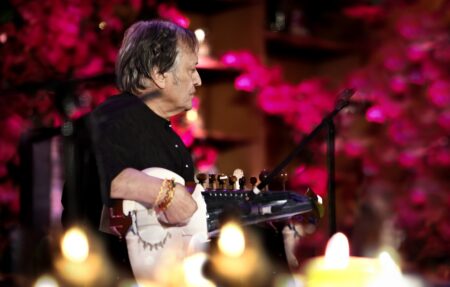Enchanting performances at Shatkala Govinda Marar Sangeethotsavam.
The annual Shatkala Govinda Marar Sangeethotsavam, organized by Kerala Sangeetha Nataka Akademi, featured two remarkable performances this year. The two-day festival took place at the Shatkala Govinda Marar Smaraka Samithy Auditorium in Ramamangalam.
The highlight of the first day was a two-hour Mohiniyattam recital by Sithara Balakrishnan, disciple of the late maestro Dr. Kanak Rele. She showcased six numbers, strictly in the hallmark Sopanam style of the Kanak Rele School. Fortunately, Kalamandalam Gireesan, a former faculty of Nalanda Nritha Mahavidyala, Mumbai, provided vocal support and nattuvangam, enhancing the dancer’s performance with the pristine purity of the style. This tribute extended to her Guru was complemented by the late doyen Kavalam Narayana Panicker’s musical scores for all the items, making the recital a homage to him as well.
The opening number, “Ganapathy,” portrayed Vighneswara in a picturesque narration. The drum syllables of Edakka, “ta ku ku, ta ku ku taka, takitam tonki,” with which the recital began, introduced the indigenous air of Kerala. Sithara’s recital of Arabhi and Anandabhairavi ragas in the Sopana style added value, skillfully delineating the spatial descriptions of the lyrics. The ancient tenet “Nritham taalaasrayam” (nritta is dependent on rhythm) remained the core of the recital, discernible throughout.
“Mukhachalam,” composed in ragamalika and talamalika, including adi and Marma (14 beats), was a garland of nritta with varied adavus, aesthetically choreographed by Kanak. Together with the musical vaytharis uttered by Gireesan, the number was a treat to the eyes. Sithara’s histrionic potential came to the limelight in the next two numbers, the Swati Padam, “Poonthen nermozhi sakhee” in adi and Anandabhairavi. The portrayal of Ashtanayikas included Vasakasajja (Khamas), Virahotkanditha (Pantuvarali), Swatheenabhathruka (Kapi), and Abhisarika (Kamboji), selected with slokas from Natyasastra for their depiction. Apart from commendable abhinaya, the utilization of space by the dancer in describing each was noteworthy.

The fourth Ashtapadi, “Chandana charchita neela kalebhara,” was staged in Anandabhairavi and adi. The relevance of the number was evident, as Govinda Marar had rendered it in the court of Thyagaraja, in six tempos, earning him the title ‘Shatkala.’ The Kanak style concluded with the highly inspiring number “Jeeva.” Composed in adi and Madhyamavati, it explained the philosophy that the jeevatma ultimately merges with paramatma. The ascending tempo stamped by the dancer added to the audience’s excitement, concluding with stillness and creating an atmosphere of tranquility.
The accompaniments included Naveen Anand (maddalam and mridangam), Arundas Srutilaya (Edakka), and Murali Krishna (vina). The team’s contribution, especially Naveen Anand’s drumming, was laudable.
On the second day, noted musician N. J Nandini enthralled the audience with a two-hour vocal concert. From the opening number, Swati’s “Jaya Jaya Padmanaba” in Sarangi and adi, to the concluding tillana, the concert was a vehement expression of the musician’s inimitable dexterity in swaraprasthara. After a short alapana, as she entered into the composition, there was a cascade shower of swaras that brought out the intricacies of the raga.

A short “Edayya gati enakku” of Koteeswara Iyer in Chalanatta followed. Thyagaraja’s “Appa Rama Bhakti” embraced an extended essaying of the raga Pantuvarali. Her ingenuity was evident in the aesthetically coined phrases while delineating the raga. The selection of the Govinda Marar composition not widely heard in music concerts marked her ouchithya (propriety) in selecting a composition of the legendary musician at whose birthplace the festival was being held. Also, she explained that since it was composed in the Sopana style, it did not follow the format of Kirtana, viz. pallavi, anupallavi, and charanam.
While she stuck to the original raga Kedaragowla and adi, she chose to render it in the Carnatic mode. Though the composition began with the line “Ksheerasagara vaasa,” she opened with “Ramamangala natha,” the third line. Further, the composition assumed much relevance as it was an invocation to Bala Narasihamoorthy, the deity of the Ramamangalam temple where Govinda Marar had performed kottippadi seva during his initial days. Also, the proximity of the temple to the venue of the concert made it dearer to the people of Ramamangalam.

“Kanakasaila virahini” of Syamasastri in Punnagavarali and adi was followed by the main composition of the concert – “Satatam taavaka” of Swati in Kharaharapriya and adi. The raga emerged gradually as she resorted to a splendid but extremely lengthy elaboration. Interestingly, one could listen to varied shades of the raga being unfolded as she progressed. Violin tani by Sunitha Harisankar was also long but faithful to the vocalist’s movements. The contribution of the percussion team in supporting the vocalist was commendable as a whole. The percussion tani by Balakrishna Kammath on the mridangam and Tripunithura Kannan on the ghatam was crisp, inspiring but also short.

Post-main compositions included Gopalakrishna Bharati’s “Irakkam varaamal” in Behag and rupakam, and one more composition of Govinda Marar, “Paalayamaam Parvatheesa” in Anandabhairavi and adi. Nandini wound up with an exhilarating tillana in Mandu, a composition of Lalgudi Jayaraman. Other traditional programs included “Keli” by Thazhathedathu Muralidhara Marar and party, “Thayambaka” by Cheranellur Sankarankutty Marar and party, “Sopana Sangeetha” recital by Ambalapuzha Vijayakumar, and “Pancharatnakirtana alapana” by Nechur Ratheesan and group.




